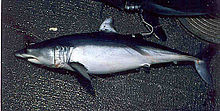Isurus
| Isurus Temporal range: [1]
| |
|---|---|

| |
| Shortfin mako shark (I. oxyrinchus) | |

| |
| Longfin mako shark (I. paucus) | |
| Scientific classification | |
| Domain: | Eukaryota |
| Kingdom: | Animalia |
| Phylum: | Chordata |
| Class: | Chondrichthyes |
| Order: | Lamniformes |
| Family: | Lamnidae |
| Genus: | Isurus Rafinesque, 1810 |
| Type species | |
| Isurus oxyrinchus Rafinesque, 1810
| |
| Synonyms | |
| |
Isurus, commonly known as the mako sharks, is a genus of fast-swimming sharks in the family Lamnidae. They are in fact the fastest-swimming shark.[2] This is in the same family as the great white shark. Isurus ranges in length from 2.5 to 4.5 metres (8 to 15 ft), and can grow to about 800 kilograms (1,760 lb). The genus has a long fossil history.[3]
There are two living species in this genus: the common shortfin mako shark and the rare longfin mako shark.
Species
[change | change source]Shortfin mako shark
[change | change source]The shortfin mako shark, as the name suggests, has smaller pectoral fins to the Longfin mako shark. The shortfin mako shark also has smaller eyes. It is smaller than the Longfin mako shark, reaching a maximum length of 3.8 metres, but weighs more, with the heaviest shortfin mako shark found weighing 506 kg (1116 pounds). [4]
The shortfin mako has a wide distribution, being found in tropical and temperate waters throughout the world's oceans. It is a true pelagic species, but it inhabits the cooler, deeper water of tropical regions. The shortfin mako shark has been recorded at depths of up to 740 metres. [4]
The shortfin mako is the fastest species of shark known, reaching speeds of up to 32 km/h (20 mph), [4] and with bursts of up to 74 kilometres per hour (46 mph).[5] Its great speed helps it to capture other fast swimming animals on which it preys. The shortfin mako shark feeds on pelagic fish such as swordfish, tunas, and other sharks, as well as squid. [4] The shortfin mako holds the record for the longest distance travel: about 2,130 kilometres (1,320 mi) in 37 days. This is an average of about 58 kilometres (36 mi) per day.[4]
Shortfin mako often leap in sets of three. The third leap is usually the highest. It can reach as high as 5–6 metres (16–20 ft) above the surface.[5] This high-leaping fish is a highly sought-after game fish worldwide. There are cases when an angry shortfin jumped into a boat after it was hooked.[6]
Longfin mako shark
[change | change source]The longfin mako shark has longer pectoral fins and larger eyes than the shortfin shark. It is longer than the shortfin, reaching a maximum length of 4.2 metres. However, it weighs less than the shortfin, weighing up to only 70 kg (154 pounds).
The longfin mako is a pelagic species, and is found in the Indian, Pacific, and Atlantic Ocean. It is common in the western Atlantic and central Pacific, but elsewhere it is rare. It is thought to be a bottom-dwelling shark, living in tropical and warm temperate waters, but this is uncertain.
Not a lot is known about the Longfin mako shark's feeding habits, but it is thought to feed on schooling fish and pelagic cephalopods. [4]
References
[change | change source]- ↑ Sepkoski, Jack (2002). "A compendium of fossil marine animal genera (Chondrichthyes entry)". Bulletins of American Paleontology. 364: 560. Archived from the original on 2011-09-30.
- ↑ Shark: BBC tv, first instalment. [1]
- ↑ Sepkoski, Jack (2002). "A compendium of fossil marine animal genera (Chondrichthyes entry)". Bulletins of American Paleontology. 364: 560. Archived from the original on 2012-05-10. Retrieved 2008-01-09.
- ↑ 4.0 4.1 4.2 4.3 4.4 4.5 "FLMNH Ichthyology Department". flmnh.ufl.edu. Retrieved 11 July 2013.
- ↑ 5.0 5.1 R. Aidan Martin. "Biology of the Shortfin Mako". ReefQuest Centre for Shark Research. Retrieved 2006-08-12.
- ↑ "A Pattern of Islands | NZETC". nzetc.victoria.ac.nz. Retrieved 2021-06-04.
